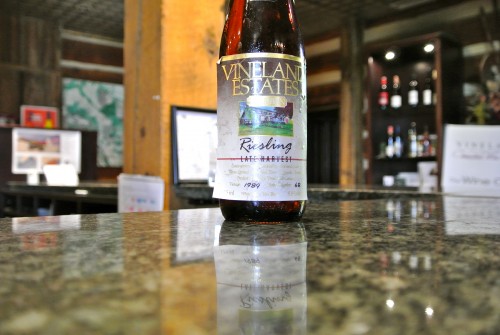 One thing is becoming abundantly clear as I explore the older vintages of Niagara’s classic wines. The memories of those who made them aren’t as clear as they once were and detailed winemaking notes just don’t exist like they do with today’s wines.
One thing is becoming abundantly clear as I explore the older vintages of Niagara’s classic wines. The memories of those who made them aren’t as clear as they once were and detailed winemaking notes just don’t exist like they do with today’s wines.
I’m getting a sense of the chaos that comes with a fledgling industry trying to find its place in the world. It was a grinding, often exhausting, exploration of what worked and what didn’t and a mad dash to sell these wines any way and anywhere they could.
It was only in 1975, when Inniskillin was granted the first new winery licence in the province since 1929, that the modern wine industry in Ontario began. Prior to that there were only six wineries in the province.
Others quickly followed Inniskillin, but they were all pioneers and dealing with myriad problems that came with a glut of hybrid grapes and replanting was needed to move to the more viable and marketable vinifera grapes.
In the 80s, the number of quality Niagara wineries making interesting wines was a short list. Building the industry was often by trial and error and predicting the palates of the day, what would sell, was frustrating and tedious work.
Riesling was a staple of the region in all its forms — dry, semi-dry, late harvest and, of course, the famous icewine, the style that put Canada on the wine map of the world.
Vineland Estate was part of the early boom in Niagara.
 Allan Schmdit, left, was born and raised in the Okanagan Valley. His family co-founders of Sumac Ridge Winery in the Okanagan Valley, and today he represents the third generation of his family to be involved in the development of this growing Canadian industry.
Allan Schmdit, left, was born and raised in the Okanagan Valley. His family co-founders of Sumac Ridge Winery in the Okanagan Valley, and today he represents the third generation of his family to be involved in the development of this growing Canadian industry.
After oenological training in California at Heitz Cellars and viticulture training in the Nahe region of Germany, Schmidt moved to Ontario in 1987 to take up the position of Winemaker and General manager at Vineland Estates. The family connection with wine continues to this day. Schmidt is president of the winery and works alongside his brother Brian, who is now Vineland Estates’ winemaker.
A little known fact: In 1993, the brothers dog sledded to the magnetic North Pole with several bottles of icewine, claiming to be the first winemakers to take icewine to the North Pole for polarized aging.
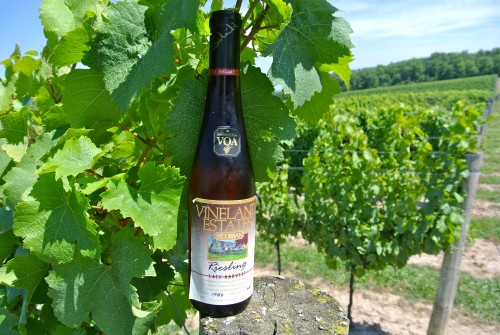 Vineland Estates is famous for its Riesling especially the Riesling from the 42-acre St. Urban Vineyard. The vineyard showcases the Weis 21 Riesling clone, brought to Canada by the winery’s founder, Hermann Weis. The first plantings went in the soil in 1979 and were followed successively in 1980 and 1981. Hailing from the Mosel in Germany, Weis was an experienced grape grower who knew exactly what would grow successfully in the Niagara Region.
Vineland Estates is famous for its Riesling especially the Riesling from the 42-acre St. Urban Vineyard. The vineyard showcases the Weis 21 Riesling clone, brought to Canada by the winery’s founder, Hermann Weis. The first plantings went in the soil in 1979 and were followed successively in 1980 and 1981. Hailing from the Mosel in Germany, Weis was an experienced grape grower who knew exactly what would grow successfully in the Niagara Region.
So what a treat to come across a bottle of the 1989 Late Harvest St. Urban Vineyard Riesling and share it with Lloyd’s brother Brian for Part IV of this Wines In Niagara series called #OldNiagara.
I have been exploring older bottles of (mostly) Niagara wines to see how they have stood the test of time. I’ve have looked at Marynissen Cabernet Sauvignon Lot 31 1991, Stoney Ridge Late Harvest Riesling 1998, and Konzelmann Johannisberg Riesling 1990 “Demi Sec” Estate Bottled. You can read those reports in previous posts.
I asked Allan, who is also chair of the Wine Council of Ontario, what he could remember about the character of his late harvest wine when he made it. Here is his (rather humorous) response:
“Weight: I was certainly much leaner in 1989 and could be considered over weight today;
“Character: I was expressive in 1989, but balanced. Today, possibly too opinionated and temperamental;
“Agability: Many would consider me over my prime, but my acidic backbone will ensure a few more decades at least.
“As for the wine I have no idea.”
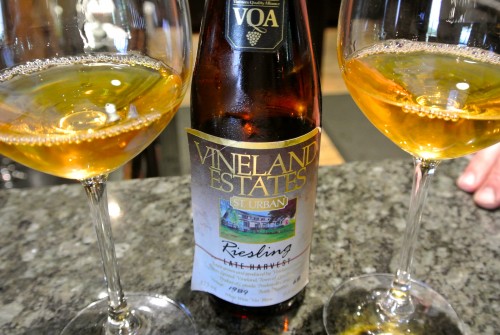 But “in all seriousness,” he said, even though he has not tried the wine for years (in fact, there are very few left in the world and he admits to having maybe one left) “I consider 1989 as one of the top five Riesling vintages during my 28 years in Ontario.
But “in all seriousness,” he said, even though he has not tried the wine for years (in fact, there are very few left in the world and he admits to having maybe one left) “I consider 1989 as one of the top five Riesling vintages during my 28 years in Ontario.
“I wish I could tell you it was because of great planning and winemaking, but this was before Brian arrived and we were flying by the seat of our pants, with minimalist equipment and using garden hoses on tanks to cool fermentations. One of the only reasons we made a late harvest Riesling in 1989 is because we could not get all the fruit processed in time for the regular wines and had no choice but to leave the fruit hanging (as) this was before nets or any effective bird control.
“So, as you know, the best Rieslings make themselves anyways, and this was no exception. I believe this was also the label that my mother hand numbered each label in the series with a red marker, her effective autograph on behalf of our family may end up being the most valuable part of this bottle you have if the wine has not survived the last 25 years.”
Indeed, the label is hand etched with the vintage and the bottle numbered (with black ink). Mine was No. 68. Brian told me later that, back in the day, labels were printed to last for several vintages and the vintage had to be hand etched on the bottle.
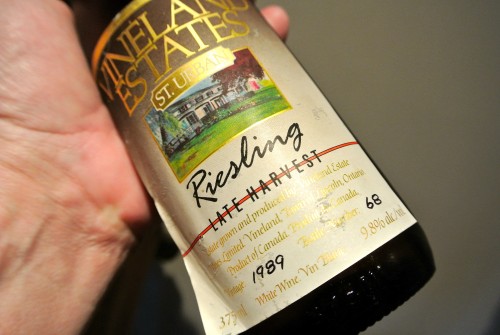 This particular bottle was in pristine condition with the cork tightly sealed and coming out of the bottle in one piece (all previous #oldniagara bottles I had opened had some crumbling and cracking issues). Toronto wine writer Konrad Ejbich, the only critic that I know of who rated the vintages in the 80s, gave 1989 late harvest Rieslings an 81 out of 100 score and recommended consumers to drink them up long ago.
This particular bottle was in pristine condition with the cork tightly sealed and coming out of the bottle in one piece (all previous #oldniagara bottles I had opened had some crumbling and cracking issues). Toronto wine writer Konrad Ejbich, the only critic that I know of who rated the vintages in the 80s, gave 1989 late harvest Rieslings an 81 out of 100 score and recommended consumers to drink them up long ago.
With this particular bottle, how wrong he was. This is a treasure and astonishingly well preserved for being 25 years old.
The aromas were immediate and profound and the colour a gorgeous golden amber. We nosed the wine and both Schmidt and I looked at each other with knowing smiles: This is going to be very interesting. The aromas ran the gamut from tropical-apricot puree and sweet marmalade to petrol, toffee and caramel. It was changing as we sniffed and swirled.
After that first taste, Schmidt exclaimed: “What a treat. We need some foie gras.”
Indeed, what a beauty and at the forefront of this Riesling was its freshness, still lively after all these years. It was lush, unctuous and concentrated on the palate with flavours of chunky marmalade and candied fruits and a vibrancy that was hard to believe.
Then the tertiary notes kicked in, the kind of flavours that only come with age: Toffee, creamy apricot, honeycomb and that sliver of sweet petrol. What an extraordinary experience, such integration and length through the finish. I can still taste it.
We left a good portion of the 375 ml bottle for Allan Schmidt to taste. I hope he admired some of his finest work.


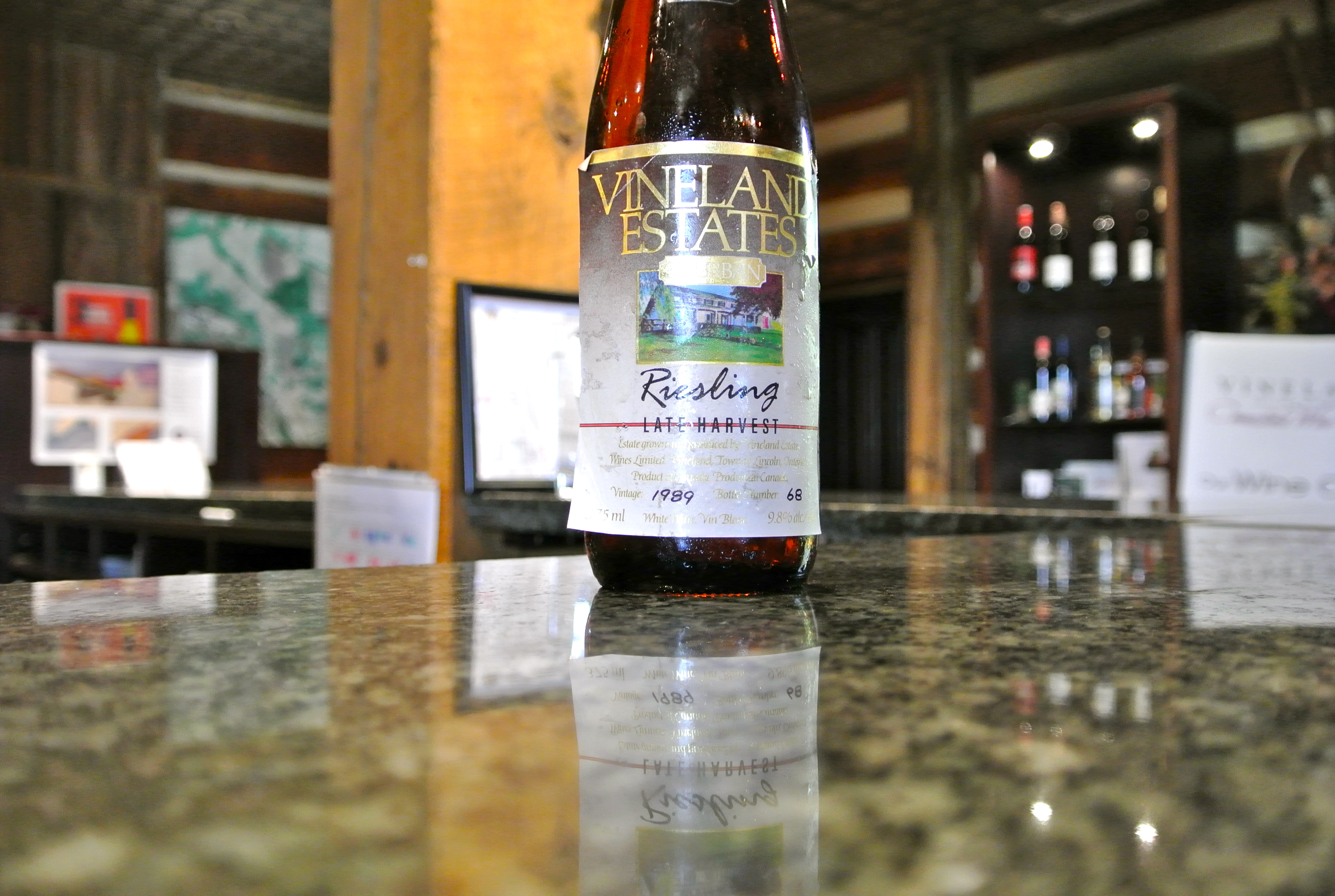



I worked at Vineland estates in the mid nineties while still in Univerity and invested in a 1990 St Urban Riesling while selling wine on the wine deck. I recently came across a bottle (uncorked) along with a 2003 Cave Springs Riesling. I had no idea of the “ageability” of these two bottles. I read with interest your comments on your blog and welcome your thoughts.
Jenn, The older Niagara wines I have been writing about have one thing in common — they were stored under perfect conditions. If you wines have been stored in a cool spot for all these years I see know reason why you won’t be amazed at what you have. Both Vineland and Cave Spring are two of the best Riesling producers in Niagara and both are built to last. Chill them, open them and enjoy! But do it soon.